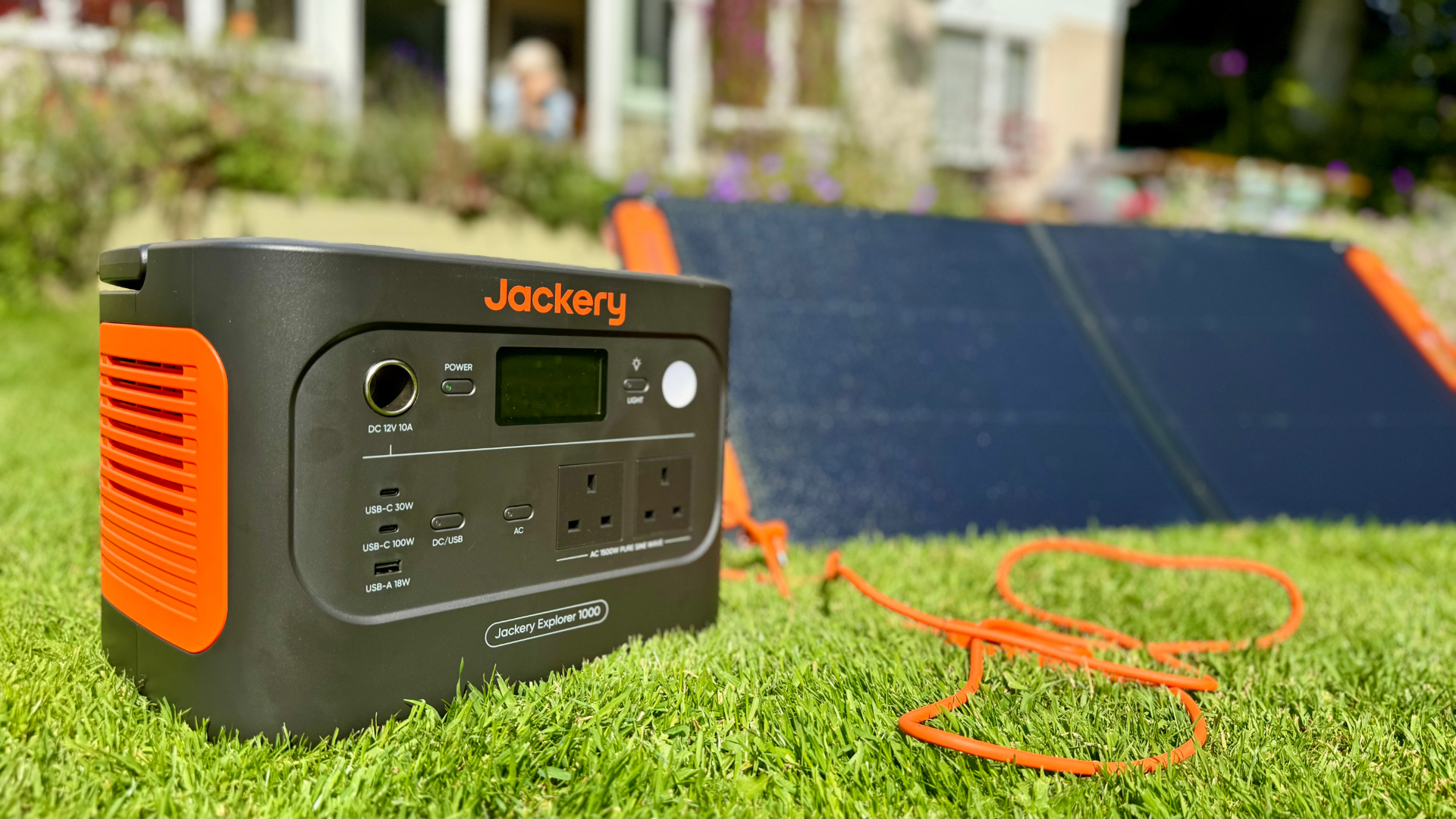Jackery Explorer 1000 v2 review: a low-weight battery juicer for thirsty devices
Fuss-free electricity for the great outdoors and household emergencies


The new Jackery Explorer 1000 v2 and 100W SolarSaga panel bundle is an ideal emissions-free power station package for both outdoor enthusiasts and emergency indoor use. It’s not too heavy or cumbersome to carry and, with up to 1.5kW of AC, DC and USB capacity on tap, it packs enough punch to power most household items including some juice-heavy devices like power tools and heaters. And when used in conjunction with the included 100W solar panel, you can be sure your off-grid camping needs are well and truly covered.
-
+
Reasonable size and weight
-
+
Excellent power specs
-
+
Plenty of outlets and ports
-
+
Comes with a 100W solar panel
-
-
No DC cable supplied
-
-
Bundle only saves you £5
Why you can trust T3

Our search for the Best Portable Power Station continues with a review of the Jackery Explorer 1000 v2, a small-formed and relatively lightweight power station ideal for car camping, caravanning, boating and emergency use at home.
Moreover, this particular model can also be purchased as a bundle with Jackery’s easy-to-use SolarSaga 100w photovoltaic panel—and at a reasonable price to boot, especially if bought directly from Jackery.
Despite summer in the UK ending, right now is a good time to consider getting yourself a portable power station because a) prices will be reduced as summer demand recedes and b) with an inevitable slew of winter storms on the far horizon and possible power cuts. As a result, a clean, silent portable power station like this might just save the day.
Is the Jackery Explorer 1000 v2 Bundle worth your hard-earned? Let’s give it a whirl.
Jackery Explorer 1000 v2 review
Price and availability
The Jackery Explorer 1000 v2 Bundle with 100W solar panel is competitively priced here in the UK at £949 and available direct from Jackery. Alternatively, you can forego the solar panel and just buy the main unit for £749, again from Jackery direct or Amazon. Just be sure not to opt for the similar-sounding Jackery Explorer 1000 Pro, an earlier model with lower-specs that is still on sale at some online stores for considerably more than this much newer variant.
If shopping in the USA, your best bundle bet is the Jackery Solar Generator 1000 v2 with 200W solar panel which ships from Jackery for $1,299. Or go solo and grab the Explorer alone for $799, again from Jackery.
Design

When it comes to sourcing a portable power station, you have several respected brands to consider – Bluetti, EcoFlow, Anker, BioLite and, of course, Jackery. Each manufacturer produces a wide range of models at different power outputs and price points but you have to remember that the more powerful the output, the bigger the batteries and, of course, the heavier the carrying weight and purchasing cost.
Get all the latest news, reviews, deals and buying guides on gorgeous tech, home and active products from the T3 experts
I think Jackery has found the perfect balance between power and weight with this new upgraded V2 version of its popular Explorer model. At 325mm in length, 245mm in height and 222mm in depth, it’s an ideal size for vehicular transportation and storage and, at 10.8kgs, light enough to carry a fair decent distance without causing a hernia. And speaking of carrying… Where the earlier model’s handle was fixed in an upright position, this one’s handle folds flat so it’s easier to store while providing a level plinth to put stuff on.
The Jackery Explorer 1000 v2’s bright and legible three-inch LED display provides basic output and input stats along with current battery capacity. However, there are a lot more features available through the app which you can read about below. Sitting alongside the display you’ll find a very handy LED lamp that produces a diffuse beam in two main strengths (dim and very bright) along with an SOS function.
Disappointingly, the Explorer 1000 v2 ships with just one cable to charge it via the mains and no DC cable for charging the Explorer from a car which almost all other power station manufacturers provide as part of their packages. Hence, if you need to charge this unit from a car you’ll need to fork out another £30 or so for a Jackery-branded DC cable.
I should also add that this power station is not especially water resistant so make sure you don’t leave the unit out in the rain. On the plus side it comes with a decent 5-year warranty.
Battery stats
Most power station manufacturers like Jackery have already started moving over to Lithium Iron Phosphate (LiFePO4) which, in the case of this model, has a lifespan of up to 4,000 charge cycles against most Li-Ion batteries which can only handle up to 500 cycles. That’s a phenomenal improvement in the lifespan of the unit as a whole – up to 10 years with normal use. More importantly, you’ll be pleased to know that LiFePO4 batteries are much more stable than standard Li-Ion because they use a non-flammable electrolyte that won't catch fire even if the battery is punctured or damaged. LiFePO4 are also much more shock resistant which is just what you need in a portable power station.
The Jackery Explorer 1000 v2 is rated at 1,500W of continuous AC output (equivalent to 1,070 watt hours) which I consider the sweet spot for a portable power station since its capacity is capable of providing juice to a myriad of devices while being compact and light enough carry it around. Yes, there will be some power-hungry devices like heaters in the home that it will inevitably struggle with but, in the main, this product will have more than enough gumption to keep most home essentials like a TV, Sky box, router and desktop computer alive while there’s a power cut. And, of course, this level of power is more than enough for outdoor pursuits like car camping, caravanning, boating and most outdoor power tool work.
Furthermore, the Jackery’s above-average 3,000W (3kW) peak surge function should be enough to handle the extra power required when you first turn on a high wattage device like a circular power saw. Once the start-up surge has passed, the Jackery should continue to power the device with no issues, as long as the device being used is officially rated at no more than 1.5kW.
The Explorer 1000 v2 provides three different charging speeds: Fast charging mode which charges it from 0% to full in about two hours; Quiet charging mode which reduces the noise of the fan but charges more slowly; and Emergency charging mode which employs 7x the speed – from empty to full in about an hour – for those times when you need a full battery and need it fast. However, Emergency mode is not recommended for frequent use.
Plugs and ports

The Jackery Explorer 1000 v2 comes with a mini smorgasbord of outputs, including two 230V 1.5kW UK sockets with 3kW surge peak, a 12V 10A DC output, plus three USB ports – 18W USB-A, 100W USB-C for laptops etc and 30W USB-C for smaller devices like phones. That’s more than enough plug-ability for any outdoor scenario and just about enough to keep most important household items going during a power cut.
Heading to the side you’ll find a three-pin kettle-style input for charging the Explorer plus two solar inputs at 200W each, which means you can hook up two 200W panels for faster sun-powered juicing. This unit also supports UPS (Uninterrupted Power Supply) which means it can be connected to the mains and, in the event of a power cut, it will continue to provide electricity with zero interruption.
Jackery SolarSaga 100W solar panel

This particular product arrived bundled with Jackery’s excellent 100W SolarSaga panel which I recommend if you plan to use the Explorer while enjoying the great outdoors. However, the bundled version we have here only saves £5 against purchasing the Explorer and 100W solar panel separately.
The SolarSaga 100W panel’s folding design with integrated handle makes it perfect for transport and I love the way the two panels snap together securely when in transit. At 610x552x35mm when folded, you should have no issues finding a slim space in the car for it. And when you get to your destination, simply open out the two panels and angle them towards the sun using the two rear elasticated stands. For maximum effectiveness, Jackery recommends using its built-in sun angle indicator to line up a tiny sun shadow with the centre of a target. Just remember to occasionally adjust the trajectory of the panel as the sun moves across the horizon.
The SolarSaga is IP68-rated for waterproofness so there’s no need to dash out of the tent to rescue it in a downpour. It also comes with a long 3m cable which means you can keep the power station in the shade or under cover while it’s being charged. However, it’s a shame that Jackery has decided to use a completely different solar input plug to everyone else. It means you will need to buy an extra adaptor if you want to use the Explorer with a third-party solar panel. On the plus side, the cable itself includes USB-A and USB-C inputs so you can charge a dead phone directly from the solar panel in an emergency.
Generator performance

For my main test I used the same heater as I usually do, a small 1.8kW Meaco blow heater with two heat settings amounting to around 800W and 1,800W. The Jackery Explorer 1000 v1 worked perfectly with the heater’s lowest setting and drew around 800W before slowly settling back at around 729W. With the Explorer at 72% capacity, the app and screen interface displayed a running time of 0.9 hr which is excellent given the amazing amount of heat the Meaco was generating – perfect for warming a tent before going to bed or boosting the tent’s temperature in the middle of the night.
However, as expected the Meaco’s higher 1.8kW setting proved too much for the Jackery to handle and it cut out after about 10 seconds. I don’t consider this an issue because having an extra 300 to 400 watts of power on board would inevitably increase the size and weight of the unit and increase its buying costs quite considerably. You get what you pay for.
I then pulled out my Smeg A Modo Mio Lavazza espresso pod machine because making good-tasting coffee is exactly the type of thing I would use a power station for when camping. The Smeg drew around 1,170 watts during the entire 30-second extraction process and, according to the readout on the Explorer’s display, this would amount to an hour of coffee making duties. That’s a lot of espresso.
Having been extremely satisfied by the Jackery’s output performance, I then ran a charging test and it charged from 50% to full in just under an hour, drawing between 770 and 990 watts from the grid in the process. Not too shabby.
Solar performance
When it came to charging the Explorer with the 100W solar panels in full sunshine the unit’s display peaked at 76 watts which was quite a lot less than I was expecting, but I put some of this down to a slight haze in the atmosphere. However – and this just goes to show how useless solar panels are in cloudy weather – the Explorer’s display showed a paltry 4% charge on a cloudy day and a projected a figure of 6.1 hours to charge the unit just 2%. Remember this stat if camping in the UK where it always seems to be more cloudy than sunny.
Jackery app

The official Jackery app is a simple two-page affair that provides access to all of the Explorer’s functions. Once you’ve synced the unit to the app, you’re taken to the main home screen with a display of the unit’s current battery capacity and buttons to assign the various outputs. You can also operate the LED lamp from this page and change the screen time from off to two minutes or two hours.
Page two is devoted to the settings and here you can change charging from Quiet charging to Fast charging or, if in a panic, Emergency charging. You can also adjust the unit’s auto-off time, select Energy Saving mode and a Battery settings choice from normal use to ‘Battery Saving Mode’, which ‘extends battery life by approximately 30%’.
Like other power stations I’ve tested, you can’t turn the Jackery on from a completely off state by using the app. This appears to be quite normal with power stations. However, unlike the humongous and extraordinarily weighty Bluetti AC240 I recently reviewed, you can’t turn this unit off with the app either. And that’s a bit of a drawback in my opinion.
Verdict

The Jackery Explorer 1000 v2’s convenient size and weight, coupled with its excellent power output, safe LiFePO4 battery chemistry and overall performance make it a worthwhile investment for camping enthusiasts, caravaners, boaters, outdoor workers and anyone who requires backup power for emergencies. Although the bundled solar panel is just £5 cheaper than if purchased separately, it’s still worth adding to the shopping basket, especially if you plan to use the Explorer in the wilderness.
Derek (aka Delbert, Delvis, Delphinium, Delboy etc) specialises in home and outdoor wares, from coffee machines, white appliances and vacs to drones, garden gear and BBQs. He has been writing for more years than anyone can remember, starting at the legendary Time Out magazine – the original, London version – on a typewriter! He now writes for T3 between playing drums with his bandmates in Red Box (redboxmusic).
